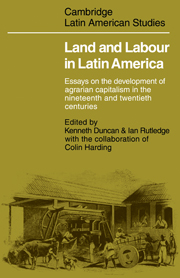 Land and Labourin Latin America
Land and Labourin Latin America Book contents
- Frontmatter
- Contents
- List of tables
- List of figures
- List of maps
- Acknowledgements
- 1 Introduction: patterns of agrarian capitalism in Latin America
- PART I THE TRANSITION FROM TRADITIONAL HACIENDA TO CAPITALIST ESTATE
- PART II THE DEVELOPMENT OF A PLANTATION ECONOMY WITH LABOUR RECRUITMENT FROM HIGHLAND PEASANT COMMUNITIES
- PART III THE DEVELOPMENT OF COMMERCIAL AGRICULTURE USING EUROPEAN IMMIGRANT LABOUR
- PART IV THE TRANSITION FROM SLAVE PLANTATION TO CAPITALIST PLANTATION
- PART V POSTSCRIPT
- Glossary of Spanish and Portuguese terms used in the text
- Weights and measures
- Notes on contributors
- Indexes Subjects
- Authors
PART I - THE TRANSITION FROM TRADITIONAL HACIENDA TO CAPITALIST ESTATE
Published online by Cambridge University Press: 07 May 2010
- Frontmatter
- Contents
- List of tables
- List of figures
- List of maps
- Acknowledgements
- 1 Introduction: patterns of agrarian capitalism in Latin America
- PART I THE TRANSITION FROM TRADITIONAL HACIENDA TO CAPITALIST ESTATE
- PART II THE DEVELOPMENT OF A PLANTATION ECONOMY WITH LABOUR RECRUITMENT FROM HIGHLAND PEASANT COMMUNITIES
- PART III THE DEVELOPMENT OF COMMERCIAL AGRICULTURE USING EUROPEAN IMMIGRANT LABOUR
- PART IV THE TRANSITION FROM SLAVE PLANTATION TO CAPITALIST PLANTATION
- PART V POSTSCRIPT
- Glossary of Spanish and Portuguese terms used in the text
- Weights and measures
- Notes on contributors
- Indexes Subjects
- Authors
Summary
David Brading's paper constitutes the essential introduction to Part I, since it provides a useful point of departure for examining the development of the hacienda system. The haciendas of the Bajio of Mexico exemplify the economic and social difficulties encountered by pre-capitalist cereal agriculture – low profitability, unstable market conditions, and above all an underlying tension between the demands of demesne cultivation and the encroachments of tenant fanning. Indeed, in the particular case studied by Brading it seems that the landowning class had practically lost this struggle even before the great Mexican agrarian revolution of 1910–17. Jan Bazant's paper takes a similar starting point, showing the conflict between large landowners and the various categories of tenant labour settled on the periphery of their estates. However, in the haciendas of San Luis Potosí, unlike the Bajío, during the latter part of the nineteenth century the landowners were relatively successful in gradually restricting the rights of their tenants and successfully converting their peones into an increasingly impoverished class of day-wage labourers, stripped of the meagre privileges and security of the pre-capitalist agrarian society.
Arnold Bauer and Ann Hagerman Johnson deal in considerable detail with the changes in land tenure and land use during the period of expanding cereal agriculture in Chile. They show that the extension of cultivation took place mainly within the boundaries of existing estates through the conversion of previously unused land, and that there was in fact little or no change in the actual pattern of land ownership. (A similar point is made by Juan Martinez Alier in his paper on the Peruvian highlands.)
- Type
- Chapter
- Information
- Land and Labourin Latin AmericaEssays on the Development of Agrarian Capitalism in the nineteenth and twentieth centuries, pp. 21 - 22Publisher: Cambridge University PressPrint publication year: 1978


